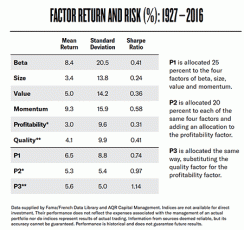Click here to download a PDF of the full report.
Factor-based investing may be the talk of the town at the moment, but it’s not a new idea. Benjamin Graham and David Dodd, authors of “Security Analysis,” first identified value as a persistent generator of above-market returns in the 1930s, and momentum, as a concept, already existed when Richard Driehaus began to popularize it in the 1980s. Style boxes began proliferating in the 1990s, while behavioral finance research first took shape in the late 1970s. Yet there’s no denying that what’s old is new again, as investors of all stripes look for ways to capture the cost-efficiency and transparency benefits of passive investing, while also outperforming market benchmarks.
Factors, at their simplest, are traits that explain returns on a cross-section of assets. “We describe factors as broad and consistently rewarded characteristics that generate returns in many different places, across different asset classes and forms of equity,” says Andrew Ang, head of factor investing at BlackRock. “These include macro factors like inflation and economic growth. They also include style factors, such as value and momentum. We’ve seen factors work in equities, bonds, commodities, foreign exchange, almost anywhere there is a liquid market.”
Larry Swedroe, director of research at Buckingham Strategic Alliance, and the author, with Andrew Berkin, of “Your Complete Guide to Factor-Based Investing: The Way Smart Money Invests Today,” employs a slightly different set of factors from BlackRock. His factors include beta, size, value, momentum, profitability/quality, carry, and term.
More of a factor than ever
Swedroe ties the rise of factor investing to the mixed results of active management. Two decades ago, he explains, around 20 percent of active managers routinely beat their benchmarks. Today, only around 2 percent do. The case for passive investment has become well-known — low costs, predictable performance versus a benchmark, and transparency. “Investors are trying to figure out, if passive investing is the way to go, how do I implement it? What factors do I want to include?” he says.
Technology, too, has played a role, as advanced computer power makes it ever easier to identify, track, and construct portfolios around factor strategies. Brian Sanborn, Director of Research Applications at Ned Davis Research, says that it’s never been easier to pursue factor strategies.
“Programming is becoming much more readily used within the workplace and higher education. There’s a lot of software out there that’s open and free to use. We’re also seeing greater availability of data, whether it’s pricing, financial statements, or macro data,” Sanborn explains. “Because of the availability of data now, and the implementation of factor investing, it’s easier for firms to put together baskets of stocks that have certain characteristics, whereas before it was much more expensive to do this. Now there are lots of ETFs that have some type of factor characteristic associated with them.”
“What’s new today is not the economic concept of buying cheap, or finding high-quality names, or gravitating towards safety and income. All of those things have been well known for decades,” says Ang. “What’s new today is the application of these concepts in transparent vehicles, identifying trends and quality names across thousands of assets worldwide, and efficiently executing factor-based strategies.”
Plenty of runway
Swedroe has analyzed the premium that each of his five factors have generated, their volatility and their Sharpe ratios — and calculated returns for three diversified portfolios that incorporate multiple factors as well (see chart), demonstrating the significant advantage in return and diversification that a multi-factor approach can bring. Notice that the diversified portfolios have a higher Sharpe ratio than any single factor approach, indicating a higher return per unit of risk.
All this has proven compelling for many investors. Yet what happens if factor-based investing becomes widespread? Will too much investing arbitrage out the rewards that early adopters have been able to reap?

BlackRock’s Ang says factor strategies currently make up less than 1 percent of equity assets under management. “There’s still a very large runway,” he says.
Here's another way of looking at it: Assets in factor strategies are dwarfed by the assets in traditional vehicles, such as passive and active funds. For example, the S&P 500 Index represented $19.2 trillion in market value at the end of 2016. Of the $8.7 trillion in assets indexed or benchmarked to the S&P 500, actively managed mutual funds accounted for $5.7 trillion. By comparison, U.S.-listed, U.S. equity smart beta ETFs represented about $224 billion – or less than 1.2 percent of the market capitalization of the S&P 500.
Unlike some strategies prone to capacity constraints, factor funds may be more able to invest new fund flows without unduly affecting the prices of securities, giving them the potential to accommodate large flows.
Even with wider application, Ang believes that factors’ effects would persist. “These factors have existed for decades and in some cases, hundreds of years, and we think that they will continue to persist because they arise from fundamental economic rationales. They are a combination of a reward for bearing risks, overcoming a structural impediment, or exploiting behavioral biases,” says Ang.
Swedroe has studied returns on factor strategies after they are published and found that, on average, premiums decay by about one-third as hedge funds and other active managers trade to exploit published research. “For example, say value stocks have outperformed, and we first discover that when a research paper gets published,” explains Swedroe. “The hedge funds come in and drive up the stock prices of the value companies, correcting the undervaluation. Now the historical value premium is bigger, but it also means that the future premium is now lower, so it can shrink. But it should never disappear, as long as there’s a risk story.”
Navigating a difficult environment
Factor-based strategies should, almost by definition, work in a variety of market environments and over long periods of time, but they all experience periods of underperformance. Swedroe has analyzed performance for each of his factors over periods from 1 to 20 years, and found that “no matter how long the horizon, each of the individual factors experience some periods of underperformance, even at horizons of 20 years. The sole exception is momentum at 20 years. However, this doesn’t guarantee future success for momentum at 20-year horizons,” he says. “But showing the benefits of diversification, no matter the horizon, the odds of underperformance are lower for each of the diversified, multi-factor portfolios than for any of the individual factors.” — Jennifer Kelly






